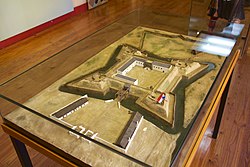Fort of Good Hope
This article includes a list of general references, but it lacks sufficient corresponding inline citations. (July 2010) |
| Fort of Good Hope | |
|---|---|
Ford de Goede Hoop | |
| Cape Town, South Africa | |
 A model of the fort as it would have appeared in the 1650s | |
Location in the Western Cape | |
| Coordinates | 33°55′27″S 18°25′27″E / 33.92417°S 18.42417°E |
| Type | Fort |
| Site history | |
| Built | 1652 |
| Built by | Dutch East India Company |
| Materials | Earth and timber |
| Demolished | Late 17th century |
The Fort of Good Hope (Dutch: Ford de Goede Hoop) was the first military building to be erected in what is now Cape Town. It was built in 1652, and was in use until 1674[1] when it was superseded by the Castle of Good Hope.
History
[edit]
The Fort was built by the Dutch East India Company, when it established a replenishment station under Jan van Riebeeck on the shore of Table Bay in 1652.[2] Constructed of earth and timber, it was square, with a pointed bastion at each corner. The bastions were named Drommedaris, Walvisch, Oliphant, and Reijger.[3] The bastions were named after the ships in Van Riebeeck's fleet.
Within the Fort were living quarters, kitchens, a council chamber (which was also used for church services), a sick bay, workshops, and storerooms. Cannons were placed on the ramparts. A nearby stream was diverted and channeled to form a moat around the fort. Being built of earth, the Fort needed frequent maintenance and repairs, especially after heavy rains.[3]
In January 1666, work began on a stone fortress to replace the Fort. It took eight years to build, and it was not until 1674 that it was ready for occupation. On 2 May 1674, the council resolved to demolish the Fort, except for some stores which were retained for a while longer, until their contents had been moved into the Castle.[3]
The Fort is sometimes confused with the Redoubt Duijnhoop, which was built some distance away, at the mouth of the Salt River, in 1654.[citation needed]
In 1732 the first Masonic lodge in South Africa was erected, Lodge De Goede Hoop, which was a branch of the Premier Grand Lodge of England.[4][5][6][7][8]
See also
[edit]- Castle of Good Hope
- Fortifications of the Cape Peninsula
- Redout Duijnhoop
- List of Castles and Fortifications in South Africa
Footnotes
[edit]- ^ Gabeba, Abrahams (1993). "The Grand Parade, Cape Town: Archaeological Excavations of the seventeenth century Fort de Goede Hoop". Fortifications of the Cape Peninsula. 48 (157): 3–15. doi:10.2307/3888871. JSTOR 3888871.
- ^ Liesbet Schietecatte; Tim Hart (November 2009). "ARCHAEOLOGICAL MONITORING AND EXCAVATION IN THE AREA OF JAN VAN RIEBEECK'S EARTHEN FORT AT THE GRAND PARADE, CENTRAL CAPE TOWN" (PDF). Retrieved 13 July 2010.
- ^ a b c Ras, A.C. (1959). Die Kasteel en Ander Vroëe Kaapse Vestingwerke.
- ^ Copper, Alan Amos (January 1, 1980). "I-Freemasonry in south Africa". The origin and growth of Freemasonry in Africa: 1772 - 1876 (PDF). University of Cape Town. p. 12. Archived (PDF) from the original on April 21, 2021.
- ^ "Celebrating 250 Years of Freemasonry".
- ^ "Lodge de Goede Hoop, Stal Square, Cape Town". July 14, 2011. Archived from the original on April 21, 2021.
- ^ John Smith. "Freemasonry in South Africa Prior to 1863". Philotecton Society. Archived from the original on March 5, 2016.
- ^ Maré, Rudolph (24 June 2016). "Review: Tour of Cape Town's Masonic Lodge".
References
[edit]- Emms, M. 'Fortifications of the Cape of Good Hope' in Lantern (June 1976).
- Ras, A.C. (1959). Die Kasteel en Ander Vroëe Kaapse Vestingwerke [The Castle and other early Cape foundations] (M.A.) (in Afrikaans). Stellenbosch University. hdl:10019.1/56521.
- Seemann, Ute A.; Castle Military Museum (1997). Fortifications of the Cape Peninsula, 1647-1829. Castle Military Museum. ISBN 9780620219907.

